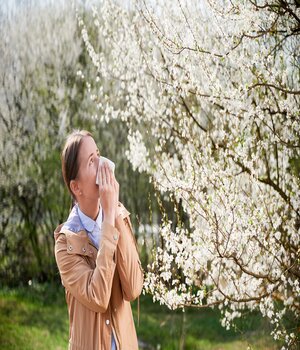Spring Means Allergy Season
Spring means flower buds and blooming trees — and if you are one of the unfortunate ones who have seasonal allergies, it also means sneezing, congestion, a runny nose and other bothersome symptoms. Seasonal allergies — also called hay fever and allergic rhinitis — can make you miserable.
Reduce your exposure to allergy triggers
To reduce the triggers your allergy signs and symptoms:
- Stay indoors on dry, windy days. The best time to go outside is after a good rain, which helps clear pollen from the air.
- Avoid lawn mowing, weed pulling and other gardening chores that stir up allergens.
- Remove clothes you've worn outside and shower to rinse pollen from your skin and hair.
- Don't hang laundry outside — pollen can stick to sheets and towels.
- Wear a face mask if you do outside chores.
- Take extra steps when pollen counts are high
Seasonal allergy symptoms can flare up when there's a lot of pollen in the air.
These steps can help you with your symptoms:
- Check your local TV or radio station, your local newspaper, or the internet for pollen forecasts and current pollen levels.
- If high pollen counts are forecasted, start taking allergy medications before your symptoms start.
- Close doors and windows at night if possible or any other time when pollen counts are high.
- Avoid outdoor activity in the early morning when pollen counts are highest.
- Keep indoor air clean
There's no miracle product that can eliminate all allergens from the air in your home, but these suggestions may help:
- Use air conditioning in your house and car.
- If you have forced air heating or air conditioning in your house, use high-efficiency filters and follow regular maintenance schedules.
- Keep indoor air dry with a dehumidifier.
- Use a portable high-efficiency particulate air (HEPA) filter in your bedroom.
- Clean floors often with a vacuum cleaner that has a HEPA filter.
- Try an over-the-counter remedy
Several types of over the counter medications can help ease allergy symptoms. They include:
- Oral antihistamines. Antihistamines can help relieve sneezing, itching, a stuffy or runny nose, and watery eyes. Examples of oral antihistamines include cetirizine (Zyrtec Allergy), fexofenadine (Allegra Allergy) and loratadine (Claritin, Alavert).
- Corticosteroid nasal sprays. These medications improve nasal symptoms. Examples include fluticasone propionate (Flonase Allergy Relief), budesonide (Rhinocort Allergy) and triamcinolone (Nasacort Allergy 24 Hour). Talk to your health care provider about long-term use of corticosteroid nasal sprays.
- Cromolyn sodium nasal spray. This nasal spray can ease allergy symptoms by blocking the release of immune system agents that cause symptoms. It works best if treatment is started before exposure to allergens. It's considered a very safe treatment, but it usually needs to be used 4 to 6 times daily.
- Oral decongestants. Oral decongestants such as pseudoephedrine (Sudafed) can provide temporary relief from nasal stuffiness. Some allergy medications combine an antihistamine with a decongestant. Examples include cetirizine-pseudoephedrine (Zyrtec-D 12 Hour), fexofenadine-pseudoephedrine (Allegra-D 12 Hour Allergy and Congestion) and loratadine-pseudoephedrine (Claritin-D). Talk to your health care provider about whether the use of a decongestant is good for treating your allergy symptoms.
Rinse your sinuses
Rinsing your nasal passages with saline solution (nasal irrigation) is a quick, inexpensive and effective way to relieve nasal congestion. Rinsing directly flushes out mucus and allergens from your nose.
Saline solutions can be purchased ready-made or as kits to add to water. If you use a kit or home-made saline solution, use bottled water to reduce the risk of infection.

